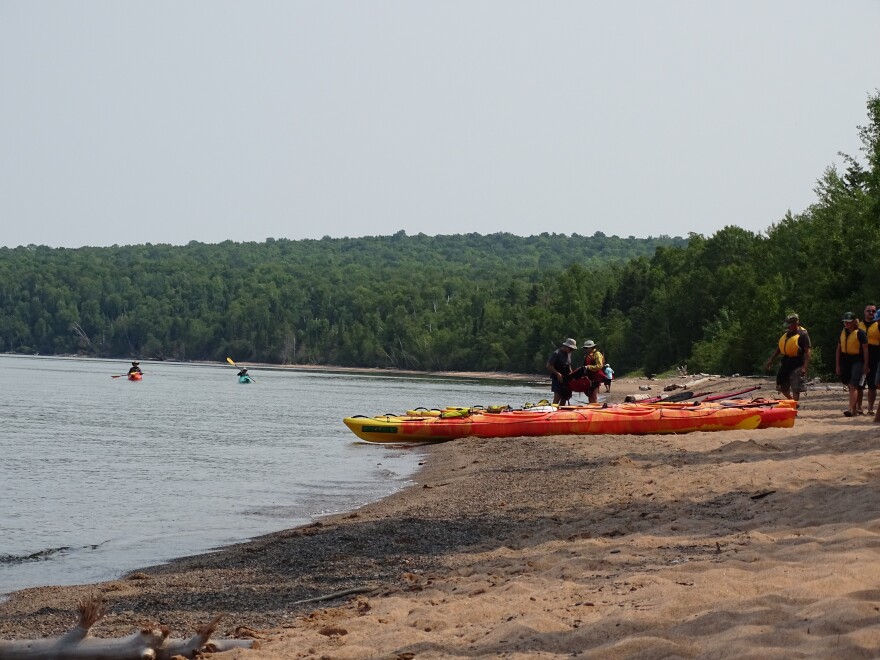Toxic algae is nothing new to the Great Lakes. Just think of Lake Erie and the bay of Green Bay.
But the last place many people, including scientists, expected to find the harmful stuff is in Lake Superior. That’s because it’s cold, deep and mostly surrounded by forest, not farm fields.
Agriculture is a common culprit — its runoff fuels toxic algae. But sporadic blooms have appeared in Lake Superior, mostly along its southern shore.
This summer, a slew of scientists are converging to try to figure out why the algae is appearing in Lake Superior and to learn whether science can help control what, so far, has only been an occasional nuisance.
It’s a calm, clear morning in Ashland, Wisconsin along Lake Superior’s southern shore. Water scientist Matt Hudson and a couple of his Northland College students are heading out to gather water samples on Chequamegon Bay.

They’ll sample each site six times over the summer to try to figure out what makes for a welcoming environment for toxic blue-green algae.
One of Hudson’s tools is a long tube-like instrument, stocked with sensors. "We just lower this thing down into the water and it gives us a whole profile of the water quality from the surface to the bottom," he explains.
To the west, off the shore of Cornucopia, University of Wisconsin-Milwaukee researcher Todd Miller’s lab is lending its toxin analysis expertise to Lake Superior researchers.

LISTEN: UW-Milwaukee Scientist Takes Toxic Algae Technology To Other Parts Of Great Lakes
Miller has deployed a system his students helped design, anchoring it off Meyers Beach — one of the most popular spots within the Apostle Islands National Lakeshore.
That’s where National Park Service aquatic ecologist Brenda LaFrancois points it out.

“The great attribute of this buoy is that it is generating data in real time. In fact, I just checked my phone before we chatted and the water temperatures are running about 18 degrees centigrade, but it’s also recording how much algae and cyanobacteria is in the water.” She continues, “And I could, if those number were starting to climb, go up and tell the ranger, 'Maybe it’s a time to watch out for any surface scum.'"
LaFrancois is an upbeat type, but she’s dead serious about harmful algae.
Cyanobacteria, commonly called blue-green algae, has a variety of “looks” including resembling pea soup. Some types — not all — can produce toxins dangerous to fish, wildlife, pets and people.
LaFrancois watches a crowd of kayakers wearing safety vests get a quick tutorial before paddling into the sparkling, open water. She says they would not have wanted to paddle here three years ago after a huge storm hit.

“People down here were reporting green-colored water, surface scums on the water. It lasted probably 7 to 10 days and it stretched over probably over 100 miles of lakeshore,” LaFrancois explains.
Six years earlier, a bloom popped up and quickly dissipated. LaFrancois says she was among the scientists who wrote it off as a fluke, but the 2018 event, she says, set off a wave of sampling and research.
This summer, more universities, state and federal agencies are prodding and poking Lake Superior. The biggest push has come thanks to the Cooperative Science and Monitoring Initiative, a program funded by the EPA.
Scientists know nutrients, especially phosphorus, feed blue-green algae, allowing it to grow. But LaFrancois says they haven’t yet figured out what would make harmful algae found in Lake Superior “switch on” its toxin production.
“It differs a little bit for different species, and unfortunately, we don’t know what makes this one go boom yet,” LaFrancois says.

Bob Sterner’s University of Minnesota-Duluth lab pivoted nearly all of its research energy to Lake Superior’s blue-green algae issue in 2018.
Right now, latex-gloved students are analyzing Matt Hudson’s samples from Chequamegon Bay. Next they’ll be head out to gather samples from other streams, shoreline areas and rivers.
Sterner says scientists concur — climate change is driving Lake Superior’s blooms.
“We just have a higher likelihood of really, really big storms now than we did," he explains. "And so, if all of this is right, the lake was sort of on edge and then it warmed up enough and we got these big storms and that just kicked it over the edge and so we’re seeing these phenomenon."
Sterner hopes building a body of scientific data can help pinpoint areas where conservation programs can help reduce the risk of algae-fueling runoff. “But we just can’t shy away form the fact that if climate is an important driver, that’s a global problem and we’re not going to fix it in Duluth or Milwaukee," he says.
Have an environmental question you'd like WUWM's Susan Bence to investigate? Submit below. (If the module isn't appearing, please refresh the page.)
_







